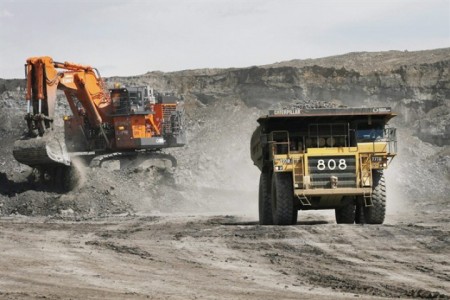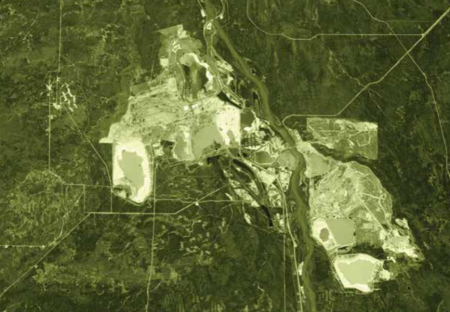June 12, 2015 – The latest blow comes from Statoil ASA, a player in the oil sands, whose chief economist yesterday called for increased carbon fees applied to the industry in Canada. Statoil operates a 20,000 barrel a day steam-driven oil sands extraction site in Alberta. The executive, Erik Waerness, said that high carbon pricing will make it increasingly challenging for high-cost producers like oil sands operators. Only significant technological innovation that drives carbon production out of the extractive process will save the industry. Statoil itself was attempting to cut carbon emission intensity by 25% in a new operation which they mothballed when world oil prices plummeted. It is doubtful that the project will see a revival in the near future if at all.
Statoil isn’t alone in calling for carbon fees. Suncor Energy, the largest oil sands operator has publicly advocated for a price on carbon. Its CEO recently remarked that climate change science is irrefutable and that carbon policy is the right thing for government to be implementing.
In the last week the scientific community here in North America made it known to the Canadian government that a moratorium should be placed on future oil sands development. A group of 100 American and Canadian scientists signed a letter and have published online a manifesto with 10 reasons why the government needs to get out of licensing oil sands and pipeline projects. The signators include members of the U.S. National Academy of Science, university professors from both countries, Nobel lauriates, Order of Canada recipients, renowned economists, biologists, climatologists, sociologists and political scientists. In their words, “based on evidence raised across our many disciplines, we offer a unified voice calling for a moratorium on new oil sands projects….no new oil sands or related infrastructure projects should proceed unless consistent with an implemented plan to rapidly reduce carbon pollution, safeguard biodiversity, protect human health, and respect [First Nation] treaty rights.”
Their 10 reasons:
- The oil sands are incompatible with climate protection.
- The oil sands inhabit the transition to a cleaner energy future.
- The oil sands are inadequately monitored with little government oversight or enforcement.
- The oil sands are contaminating surrounding land and aquifers.
- The oil sands operators have done insufficient reclamation of lands where extraction has ended.
- The oil sands are in direct conflict with First Nation treaties.
- Continued development has global repercussions in addressing climate change elsewhere.
- Energy alternatives exist that are low-carbon and that will not negatively impact the country or the global economy.
- Current proposed pipelines and oil sands projects ignore the social costs of development and their cumulative impact.
- Canadians and the majority of Americans expect their government leaders to act on climate change and they are willing to pay more for energy to help make that happen.
This manifesto comes in the same week that The Canadian Association of Petroleum Producers announced that oil sands production is expected to account for a 43% increase in production growing from 3.7 million to 5.3 million barrels per day by 2030. The industry believes the silver bullet is decreased carbon intensity per barrel through process innovation. Technological innovation would then help the country meet its international carbon reduction pledge of 30% below 2005 levels, meanwhile the oil sands producers could keep upping the barrel amounts.
The truth for the Canadian government, however, is entirely different. There is no silver bullet concludes a report commissioned by the federal government, written by the Council of Canadian Academics. Panel Chair, Eric Newell, a former CEO of Syncrude, stated, “What I hope the report might do is create a sense of urgency.” Think about that statement in the context of the G7 announcement this week to phase out fossil fuels by 2100. I guess urgency has a different meaning to our G7 political leaders.
The federally commissioned Council was asked a question followed by three sub-questions. The question was:
“How could new and existing technologies be used to reduce the environmental footprint of oil sands development on air, water and land?”
The subquestions were:
The Council talked about the use of current technologies as a non-starter with emissions and use of water and other resources increasing significantly, and with global rather than just local or regional implications.
The Council noted that using current processes greenhouse gas emissions would rise by 300% by 2030. It also stated that there are few technologies that can significantly reduce greenhouse gas emissions from these processes, and “no suite of technologies deployable in the near to midterm” to achieve an absolute reduction in the industry’s environmental footprint.And in one of its recommendations it suggested the use of “low carbon energy sources” to help in oil sands production. Of course carbon capture and sequestration was suggested but to make it worth the industry’s while, a price on carbon would be necessary.
The Council’s focus was about ways to continue exploiting the oil sands in an environmentally sustainable way. It realized that only Manhattan Project scale investment could make oil sands extraction and production as carbon free as possible. But it wasn’t asked if any of this made sense in a world moving to decarbonize energy production in light of anthropogenic climate change.
The Council was also asked to look at the larger environmental implications of the oil sands, not just the carbon emissions. Could it find promising technology that could make the tailing ponds go away? These ponds are enormous and clearly visible from the International Space Station when it orbits overhead (see image below).
The ponds made headlines in the past when migrating birds landed on them and died. They contain residual bitumen mixed in with sands and clay particles too fine to filter out economically with present day technology so the water can be discharged into available watershed. Instead the ponds lie right next to the Athabaska River and are shored up by dikes and levees to ensure they don’t leak. There is some evidence that leakage is happening and this remains a danger to the downstream human communities, almost all First Nation, and the basin’s wildlife. And should a tailing pond breach it would have a devastating impact on the entire ecosystem of the Athabaska and the immense Arctic watershed of the Mackenzie River to which it flows.
So for many reasons the oil sands represent the ultimate environment versus economy challenge. The Council concluded that business as usual is insufficient and that innovation based on intensity targets is not enough. Today intensity is the only measure the industry chooses to pay attention to.
The Council further stated, “new technologies, especially those that can potentially bring major reductions in the environmental footprint, can take 10 to 20 years or more to develop and implement.”
Consider the government’s 2030 carbon reduction pledge and you wonder what our leaders have been smoking.
Another dose of reality for you to ponder. Of the $2 billion spent in Canada in 2013 by industry on technological innovation in the energy field $888 million went into oil sands research while $120 million was spent on renewable energy. These are hardly equivalents. And neither investment comes close to the cost equivalent to a modern-day Manhattan Project which back in World War II exceeded those amounts considerably. The ratio of 88% oil sands versus 12% renewables shows you just how the country’s business leaders still didn’t get the implications of climate change on future business.
Today we are stuck with a bad bet by the current and previous governments of Canada and Alberta, and the energy industry, who have largely put their money on oil sands to drive our energy future. None of them envisioned a world that was going to make decarbonizing energy the prime global directive because of anthropogenic climate change. The bet they made at the time seemed really good. But now, not so much.












